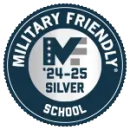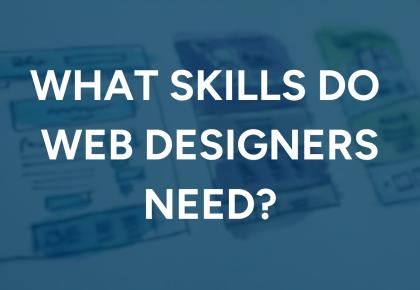Complete MKCM-102 or WEBD-125
Spring term A begins. Apply by Jan. 1.
Spring Term B begins. Apply by Feb. 26.
Summer Term A begins. Apply by April 23.
Explore Web Design & Development
Capitalize on the growing demand for web developers and designers with a web design & development associate degree. Champlain's web development degree will familiarize you with both creative design and coding, and help you hone your existing web skills or launch your career in this dynamic field.
Learn how to finish your program faster with credit for prior learning and experience.
Build Your Career Future
With an integrated approach, our online web design and development associate degree will help you build key technical skills (including knowledge of over 19 key applications, platforms, and programming languages, listed below) including javascript, HTML, CSS and design fundamentals such as user experience (UX) and usability through layout and graphics in addition to in-demand soft skills such as problem-solving and communication. You'll emerge prepared for your web design career, ready to build fully functional, well-designed websites that are effective, user-focused, secure, and achieve business goals. Plus, the web design associate degree it's a solid stepping stone toward a full bachelor's degree in web design and development for those who are returning to school after time away, or embarking on their first degree.
Program Curriculum
Learn more about Champlain's 100% online web design & development associate degree, designed for working professionals.
Champlain's web design degree online courses encompass the top skills needed by today's web professionals. Graduates of the web developer associate degree program are required to complete the following courses.
Professional Courses (39 credits)
General Education Courses (21 credits)
This course provides students with an understanding of the many different devices and technologies, from historical to emerging, that are required to design and build networks. In a broad survey of concepts and terminology, students will learn about topology, communications, protocols, and security, and to diagram basic networks to specification.
From day one, students in this course are problem solving, first in terms of algorithmic design and then as early as week two via programming in the latest version of Python, using PyCharm. Students begin by writing a program to have a conversation, having strings and numbers as input, and advance, by week seven, to building a working password saver program, capable of looking up, adding (and encrypting), and storing passwords.
This course, through guided research and hands-on learning experiences, provides students with an understanding of operating systems, including their core fundamental principles and how they work. Students are introduced to the three most popular operating systems for personal computers (Windows, OSX and Linux), and mobile operating systems, and learn about standard functions such as memory, process/thread, input/output, storage and device management.
Learn the basics and more in this course on Relational Database Management Systems (RDBMS) and SQL (Structured Query Language). Students propose a final project in the first module and then work, week-by-week, to design, create, and populate the database. Then, students learn to create queries and stored procedures.
Today's high-quality digital images are as much art as they are science. In this course, students learn to use Adobe Photoshop to prepare and create images for web use. Hands-on activities develop familiarity with tools like eyedropper and quick mask, but also challenge students to create vector shapes and incorporate typography into the design of an ebook cover. Students also must create an email campaign and redesign a web site to specifications.
From storyboard to form creation, students walk through the steps to create a basic four to five-page website to specification in this course that introduces HTML5 and CSS. Hands-on assignments reinforce skills development and best practices in design: navigation, column layout, image editing and usage, fonts and tables.
Great websites are created with specific audiences in mind and are the culmination of a process that includes creating messaging and developing a strategy that maps out the best content and functionality to reach the audience and influence its behavior. In this course, students begin with a SWOT analysis and development of a mission statement, and then create a sitemap and content, before publishing a website and blog.
Websites must balance technology with aesthetics. In this course, students study web design patterns and personas, and then create a wireframe storyboard with at least four panels designed for a standard desktop view. Students use Mockups 3.
Prerequisites
This course examines web servers from the page "in" rather than website design, which is from the page "out". Students learn the differences between TCP and UDP, gain an understanding of XML, and build a use case for a course enrollment system. Hands-on labs allow students to use ping and traceroute, and create XAMPP alias directories.
Complex web page designs fully utilized all the functionality provided by the browser. In this course, students complete a variety of hands-on assignments as part of a redesign of an existing site. One week they recreate a page using appropriate HTML5 tags, while in another they implement drag and drop functionality that must work when the site is displayed in the Chrome browser. Later in the course, students animate transitions and build a basic responsive version of the site.
Prerequisites
WEBD-125
Students who want to build database-driven or interactive web sites benefit from this course which covers PHP and MySQL along with how to build sites that incorporate authentication and security. Each week hands-on assignments are used to reinforce concepts. Students advance from an introduction to PHP and basic syntax, to handling user input and manipulating arrays in web forms to queries.
Prerequisites
WEBD-125, CMIT-200
Hands-on learning begins in week one when students must create a Pen in CodePen before they can submit a short program written in Javascript and continues through the final project in which students produce a web application that contains specific elements. Functions, objects, and events, but also DOM (Document Object Model), AJAX (Asynchronous Javascript and XML), and JSON (Javascript Object Notation), are presented in this course.
Prerequisites
WEBD-225, CMIT-135
Project Management is the formal application of knowledge, skills, tools, and techniques to project-based activities to meet organizational requirements. Project management is accomplished through the use of processes such as Initiating, Planning, Executing, Monitoring and Controlling, and Closing. Project managers can divide projects into these phases to provide better management control with appropriate links to the ongoing operations of the organization. Collectively, these phases, known as the project life cycle, form the foundation for the practice of project management and are guided by the Body of Knowledge from the Project Management Institute (PMI).
This course introduces students to the foundational concepts needed to communicate effectively in writing for academic study and professional development. Students will also learn to read critically to evaluate an author's message. Students will be introduced to rhetorical modes and their role in the development of written communication. Students will also learn how to use revision strategies to create written communication that meets its intended purpose for its intended audience
This course builds on students' proficiency in the writing process and rhetorical modes to introduce the use of sources in written communication. Students will practice information literacy as they learn to determine information needs from sources, develop effective search strategies, and incorporate sources in written communication, legally and ethically.
Prerequisites
Complete ENGL-100
Starting with a frame of human communication as a dynamic system of interactions in which people make choices that impact their relationships, other people, and themselves, students will define theory-informed communication concepts and processes, and critically examine how they apply to everyday life across a variety of contexts. Students will reflect on how the theory, concepts and processes apply to their own lives in becoming competent communicators who are knowledgeable, skilled, and versatile.
Students will learn and apply critical inquiry skills to analyze persuasive communication created by others and to develop persuasive communication/arguments of their own to solve problems in professional, civic, social, and personal contexts. Specifically, students will learn to recognize fallacies in logic; apply inductive and deductive reasoning strategies to the interpretation and development of persuasive communication; evaluate the validity of sources; and develop logically sound persuasive communication. Students will explore the roles of self-awareness, empathy, and ethics in the context of critical inquiry and the development of arguments.
Prerequisites
Complete ENGL-110.
Mathematical reasoning, when applied to everyday and professional lives, has two dimensions: logic for deterministic situations and probabilities for non-deterministic situations. This course aims to help students develop these mathematical reasoning skills.
This course introduces students to basic statistics for data literacy. With a focus on exploring real-world data, students will interpret numerical information and utilize the tools necessary to complete the entire statistical process: designing a study; gathering, organizing, and analyzing sample data; and making inferences about a population. Students will demonstrate data-driven decision-making and effective communication of numerical data.
Introduces students to the biochemistry and physiology of nutrition and exercise. Emphasis will be placed on human body systems such as musculoskeletal, digestive, respiratory and circulatory, and their relationship to nutrition and fitness. Students will also study the biochemistry of energy conversion as it relates to exercise physiology. Laboratory sessions are designed to reinforce, by a hands-on approach, the principles discussed in lecture. Course includes two laboratory hours per week.
Students will develop the ability to apply scientific methods to understand the natural world, to identify scientific aspects of daily life, and to evaluate the quality of scientific information based on its source and the methods used for its generation.
In this course, students will gain an introduction to classical mechanics and learn about motion, force, energy, and momentum. The course covers vectors, scalars, and coordinate systems, as well as kinematics in one and two dimensions, Newton's Laws of Motion, circular motion, and kinetic energy and work. Students also learn about potential energy and energy conservation, collision theory, rotational motion, moment of inertia, torque, rotational dynamics, and angular momentum.
With pressure and release, a window opens and closes, recording light on a sensor. The simple action captures the instinct, judgement, and skill of the person behind the lens. This class will begin a study of the art and craft of photography. Students will develop their vision and their understanding of how to achieve it. Solid skills will be learned and many doors will be opened.
A survey of the continuing change experienced in art since the 15th century. Students will examine how an image is achieved as well as the significance of the subject represented. Individual inquiry concerning the nature of art is encouraged.
Students learn to appreciate films through the critical analysis of various elements of mise-en-scene, cinematography, editing and sound. The course introduces the conventions of classical Hollywood cinema, considers the work of one major director (auteur), and surveys selected international and independent films. Students view and discuss films each week.
Students in the course will explore the cultural history of the music genre broadly referred to as rock. Students will explore the social, economic and political contexts that are influenced by and that influenced each style in the United States. By listening, watching, reflecting upon, discussing and writing, students will explore how music takes on meaning, personally, and culturally. Topics and themes include the relationships between and among gospel, country, funk, folk, disco, rap and hip hop; the role of business and technology in those relationships, and political or transgressive elements of rock music.
This course introduces students to the fundamentals of substantive criminal law. With this foundation for understanding the legal system students will identify the essential elements of crimes, including the criminal act, criminal state of mind, and jurisdiction. They will examine the rationale underlying criminal law, factors affecting criminal responsibility, and legal defenses. By analyzing real-world scenarios, students will develop skills to distinguish lawful from unlawful actions and prepare for advanced studies or careers in criminal justice.
This course focuses on the rules and procedures governing how the American criminal justice system must process individuals suspected, accused, and convicted of law violations.
In this course, students will explore the theory and fundamentals of criminal investigation, emphasizing practical applications for evidence handling and case development. Students will review basic responsibilities of investigators and protocols for report writing, evidence collection, and preparation of cases for trial. The curriculum examines investigative approaches for various crime categories, including violent offenses, property crimes, terrorism, and hate crimes, while introducing comparative perspectives from diverse legal systems.
Prerequisites
Take CRIM-120.
Principles of Economics introduces the fundamental concepts of economics - the study of how people manage resources, and how they react to scarcity. This course focuses on both microeconomics (the behavior of consumers and companies) and macroeconomics (large-scale economic factors such as employment and interest rates), so that you'll gain a broad understanding of how a modern market economy functions, how decisions in business settings are informed by economics, and how economics applies to your everyday life.
Students will study important themes in the social history of the United States since the Civil War. This course allows students to expand their critical thinking skills through an examination of primary and secondary sources. Themes might include: the evolving status of women; the immigrant experience; the concept of the American dream; the paradox of freedom vs. slavery; the minority experience; the tensions between social classes. Students will be evaluated primarily on writing assignments.
Students will learn how to create conditions for successful conflict engagement, a necessary skill for any professional. The course focuses on the foundational capacities to remain calm and connected with oneself and others. In this state students can access helpful ideas and responses and be their best selves regardless of environment. Improving facility for conflict creates stronger relationships and reduces fear. By the end of the course, students will understand that disagreement and difference can become a source of personal and interpersonal growth.
In this course, students will explore broad, foundational knowledge in psychology, including its history, major theorists and a survey of psychology subfields such as developmental, cognitive and social psychology. Students will also describe and assess the role of ethics and social responsibility in the study and application of psychological theory and practices.
In this class, students will explore how social relationships, groups, societies and culture develop and change over time. From a sociological theory foundation and employing the sociological imagination, students will examine the impact of social structures, institutions, and systems on individual lives. Students will apply sociological research methods to investigate sociological phenomena in their own lives.
This course explores the complex and evolving relationship between human beings and technology. Through a multi-disciplinary approach that draws on fields such as sociology, psychology, philosophy, and history, students will examine the ways in which technology has shaped human culture, identity, and values, as well as how humans have influenced and continue to influence the development, adoption and use of technology.
Additional Program Details
Graduates of the web design & development associate online program will demonstrate the following industry-specific skills, knowledge, and competencies:
- Employ fundamental computer theory to basic programming techniques.
- Use fundamental skills to maintain web server services required to host a website.
- Select and apply markup languages for processing, identification, and presentation of information on web pages.
- Use scripting languages and web services to transfer data and add interactive components to web pages.
- Create and manipulate web media objects using editing software.
- Incorporate aesthetics and formal concepts of layout and organization to design websites that effectively communicate using visual elements.
As of the Fall 2025 semester, the learning outcomes of this program will be:
- Design and develop responsive, user-centered websites by applying foundational markup to create interactive and accessible digital experiences.
- Create efficient database solutions using relational database design principles to support dynamic web applications.
- Evaluate and integrate server-side and client-side scripting languages to build secure, scalable, and functional web solutions.
- Apply networking fundamentals and operating system concepts to configure and manage secure web hosting environments.
- Create visually engaging digital content by utilizing design principles and industry-standard tools to enhance website usability and user experience (UX).
- AJAX (Asynchronous Javascript and XML)
- CodePen
- CSS
- DOM (Document Object Model)
- HTML5
- Javascript
- JSON (Javascript Object Notation)
- MySQL
- Photoshop
- PHP
- PyCharm
- Python
- Relational Database Management Systems (RDBMS)
- SQL (Structured Query Language)
- TCP
- UDP
- VMware
- XAMPP
- XML
Our admissions team seeks to admit students who:
- Demonstrate a solid academic foundation - a minimum 2.5 GPA is our recommendation, though exceptions may be made on a case-by-case basis for those who demonstrate a potential for academic success in other ways.
- Possess an aptitude for success in an online learning environment.
- Exhibit the ability to make a positive contribution to the Champlain College Online community.
To learn more about submitting transcripts, or requirements for home-schooled students, those educated abroad or returning students visit our Undergraduate Admissions page.
Our transfer credit evaluation team works hard to ensure you get the transfer credits you deserve, from a variety of sources including prior college credits, work experience and training, military training and experience, and more. Our goal is to help you graduate from Champlain College Online as quickly and affordably as possible. Visit our Transfer Credit Options page to learn more.
Champlain College Online's computer science faculty, led by Department Chair Richard Pickering, are expert practitioners in the field. Their industry expertise ensures that our curriculum is aligned with the needs of employers, and reflects the skills today’s IT systems professionals need for success. Classes led by our seasoned experts will give you real-world insight into the world of information technology, and create a rich community of career-focused learning.
Tuition & Costs
Online Undergraduate Tuition Fall '25 - Summer '26
* Alumni is defined, for this tuition rate, as any degree program graduate from Champlain College or Champlain College Online.
** Veteran rate effective Spring 2025, not retroactive
See the undergraduate cost of attendance and fees here
Affordability and Paying For Your Education
We provide a number of options to make your online education affordable, including preferred tuition for alumni, associate degree graduates, community college graduates, and military.
Move Your Web Design & Development Career Forward
Web development careers are expected to grow 13% between 2020 and 2030, much faster than the average for all occupations. The median annual salary for web developers is $77,200.*
The high demand for web design and development services across the business world means that job opportunities are available in virtually any industry, including computer systems design, creative services, finance and insurance, education, and nonprofits.
*Source: Bureau of Labor Statistics (BLS), 2020; job titles: Payscale, 2020
Top Jobs: What You Can Do as a Web Developer with an Associate Degree
- Front End Developer
- Graphic Designer
- Web Designer
- Web Developer
- UX Designer

Why Champlain
Affordability
"With Champlain's transfer credit policy, I was able to apply much of the education I had already received toward my bachelor's degree, making it much more affordable. I feel like the value I received from the program way outweighed the price I paid for it."

Academic Excellence and Recognition

Regionally accredited by the New England Commission of Higher Education

Designated as a Military Friendly School for our commitment to the military community
Ranked among the best by Tech Guide for game design and computer science

Named the among the best schools with accelerated bachelor's degrees by Intelligent.com
Meet the Program Director
Daniel Selicaro, MS
- Computer Science (BS)
- Software Development (AS, BS)
- Web Design & Development (AS, BS)
- Software Engineering and Project Management (MS)
About
Daniel Selicaro is an Assistant Professor and Program Director for Technology at Champlain College Online. He oversees bachelor degree programs for Software Development, Web Design and Development, and Computer Science, as well as the graduate program in Software Engineering and Project Management.
Dan has been at Champlain College since 2007, and has been teaching web design and development for Champlain since 2015. He began his career in print journalism as a newspaper reporter, and was the news editor for Upside magazine and the Red Herring magazine in California. After moving back to the East Coast, he worked on digital marketing at Champlain College, and was an active part of two redevelopments of the College website, champlain.edu, before he took a role in the Information Systems department.
Outside of Champlain, Dan runs his own website development company, and is on the board of directors for several local organizations — including as marketing chair at the Fellowship of the Wheel mountain biking club, the Green Mountain Montessori School, and the Essex United Soccer Club. He is an avid mountain biker, and loves to spend his time adventuring in Vermont with his two young children.

Frequently Asked Questions
Following are some frequently asked questions about our associate of science in web design and development.
A web developer handles the technical aspects of website or web application creation using languages like HTML, CSS, and JavaScript. In contrast, a web designer focuses on visuals such as layout, color scheme, typography, and imagery using tools like Adobe Photoshop or Sketch. While some individuals may have skills in both areas, these roles are usually separate in larger projects requiring specialization.
The time it takes to become a web developer and designer can vary depending on your starting point, the level of expertise you want to achieve, and how much time you can dedicate to learning and practicing. In general, it can take anywhere from a few months to a couple of years to become proficient in a development or web design career.
To enroll, you’ll need a high school diploma or equivalent. No prior coding experience is necessary.
Yes, Champlain College Online accepts transfer credits. Contact an admissions advisor for evaluation.
Yes, financial aid options, including grants, loans, and scholarships, are available for eligible students.
Absolutely! The associate’s degree serves as a stepping stone toward pursuing a bachelor’s degree in web design & development or related fields.
You May Also Be Interested In
Get Your Web Design & Development Program Guide
Learn what you can expect from our associate in web design & development program.

Download Program Guide
I acknowledge that, by clicking the "submit" button, I am giving my express written consent to Champlain College and its representatives to contact me about educational opportunities via email, text, or phone, at the phone number above, including my mobile phone, using an automatic dialer, or pre-recorded message. Message and data rates may apply. I understand that my consent is not a requirement for enrollment, and I may withdraw my consent at any time.






